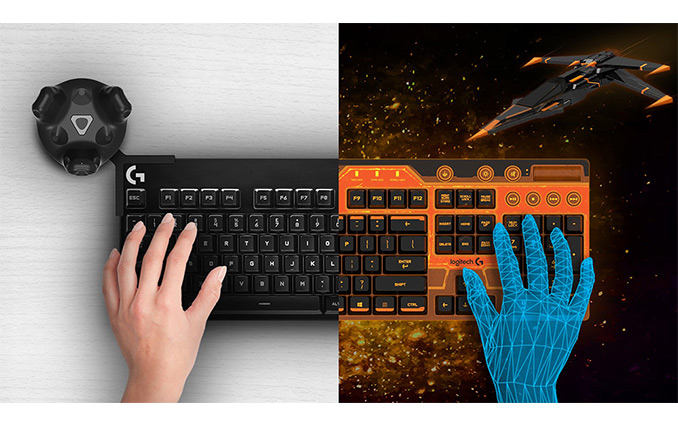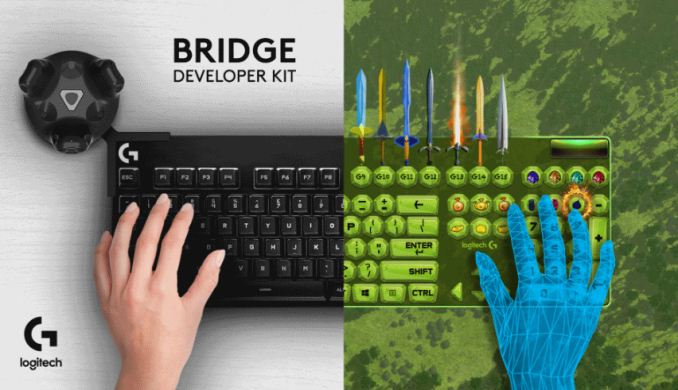Logitech and HTC Team Up to Integrate Physical Keyboards Into VR Environments
by Anton Shilov on November 7, 2017 11:00 AM EST- Posted in
- VR
- HTC
- Logitech
- Logitech G
- Vive

Usage of traditional physical controllers in virtual reality environments is surprisingly complicated, and usage of keyboards in the same environment is barely possible at all even for experienced typists. This despite the fact that physical keyboards are beneficial even in VR for various applications, including gaming and productivity, which had pigeonholed VR developers into making use of sub-optimal input schemes for their software. However the good news is that this problem may soon be coming to an end, as Logitech and HTC have announced that they are teaming up to enable usage of real keyboards with tactile feedback in virtual worlds.
Logitech on Friday introduced its Bridge software development kit, which designed to enable programmers to implement usage of a physical keyboards into their virtual reality applications. The kit consists of a Logitech G810 Orion (based on the picture) with a special mounting accessory that attaches a Vive Tracker to the top left corner of the keyboard, and the associated software. The Logitech G Bridge SDK (beta version) will be available for $150 to developers selected by Logitech. Interested parties need to apply to Logitech for the kit by November 16th.
Logitech and HTC are not explaining precisely how their technology works, but based on the press images they've sent out, the Vive Tracker senses positioning of hands above the keyboard, whereas software renders the keyboard and recreates movements of hands in virtual worlds. Logitech claims that such approach can help create virtual context-aware keyboards for both gaming and non-gaming applications. For example, they have managed to implement a keyboard across the Steam VR system.
The general principle of the Logitech G Bridge seems to be rather versatile; it may be used for various applications and re-created by other VR platform holders. Meanwhile, there is a major caveat with the method: latency. The Vive Tracker may feature a “low latency”, but it is definitely not as low as the real time. Therefore, the software is going to recreate movements of hands with a delay, possibly after the system registers actuation of a key.
Obviously, latency is a challenge for VR in general and platform holders (HTC, Oculus VR, etc.) are trying to address this issue. Over time, input latencies will shrink and this is when physical keyboards in VR worlds will shine. In the meantime, software developers can prep programs that can support physical keyboards properly.
Related Reading:
- Logitech Announces The CRAFT Keyboard With Creative Dial Integration
- Logitech’s G613 "Lightspeed" Wireless Mechanical Keyboard Cuts Wires & Input Lag
- HTC Permanently Cuts Price of Vive to $599
- Oculus Announces Six Week Sale of $399 Rift + Touch Bundle
- HTC & Intel Partner on WiGig Wireless for Vive VR Headset
- Google I/O 2017: New AR/VR Experiences
- Dell Launches 'VR Ready' XPS 27 AIO: 4K, Core i7-7700, Radeon RX 570, 10 Speakers
- Logitech Acquires Saitek Brand and Product Lines, Expands Its Sim Controllers Biz
Source: Vive Blog












6 Comments
View All Comments
DanNeely - Tuesday, November 7, 2017 - link
Is this going to be tied to a specific keyboard or will it work with arbitrary physical layouts? eg widths of bottom row keys, total number of keys on the keyboard, shape and size of shift and enter keys (internationalization is fun), laptop vs desktop, media keys, etc?Other than make you buy our stuff shenanigans I don't see any reason why all of the above shouldn't be doable (mapping the keyboard layout once should be less work than high position real time tracking to show it in VR); but Logitech and HTC's priorities here probably don't align pefectly.
quantcon - Tuesday, November 7, 2017 - link
This should work with any object (not just keyboards), given an exact 3D model of the object. That's what the Vive Tracker is meant for. I'm not sure how they're tracking hands.CaedenV - Tuesday, November 7, 2017 - link
.... with the cost of the Vive it would still be cheaper than that OLED keyboard that came out a long while back that let you have custom keyboard layouts lolPeachNCream - Tuesday, November 7, 2017 - link
Wouldn't it make sense to put sensors inside the keyboard?edzieba - Tuesday, November 7, 2017 - link
This basically uses the known keyboard image (due to external tracking) as a 'greenscreen' for the webcam in the front of the Vive to pick out your hands, as the camera alone is worthless for tracking on its own. A similar effect without the need for a front-facing camera could be to use a keyboard with non-contact sensing (e.g. the old Microsoft prototype: https://www.youtube.com/watch?v=Y3dUeGNIX4M), which has the advantage that you do not need to keep the keyboard within the camera's field of view (as the camera only covers a small portion of the view).Lauren Shawn - Monday, November 13, 2017 - link
Worth a read, thanks! Love this content! Can I repost it on my blog<a href=»http://buildvrsoft.com/»>buildvrsoft.com&l... leaving a link to you as a source?